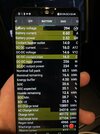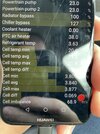The hurt by 100% is a myth.
Theres about the same degradation at 80-90% as at 100% for normal temperatures.
You can see the degradation (calendar aging) being about the same from about 70-100%
No one recommends to always have it at 100% but the “must drive asap” is not true.
that's great.
Imbalance comes from the different capacity. If your cells voltage are “perfectly balanced” in the middle SOC, when charging the cells with less capacity will reach a higher SOC (as all cells in series reach get the same amphs), this means they also reach a higher voltage as higher SOC = higher voltage.
Thats the reason.
If you balance the cells perfectly at high SOC the balance will be higher the lower the SOC, for the same reason as above.
Yes, totally agreed. As you know, I'm trying to balance the pack at 100% SOC. as
@islandbayy wrote above, I'd like to have my pack healthier and my BMS calculations more correct.
But as
@David99 mentioned, the BMBs and BMS are passively bleeding the high voltage bricks to balance the whole pack. So they could not prevent the problematic brick from charging. Agreed here too, But what if this BMB is defective and is trying all the time to bleed this brick and exactly this prevents this one to get fully charged. I found in other threads out, that the resistors of BMBs can get corroded or something like that.
Also, as I noticed, this last one month the car is going not so often in deep sleep as before.
You can write to me, that not the BMB is defective but there is one cell in the brick which has short and because of this it's bleeding the whole brick.
But, as I monitored the situation, I can say, that if the car goes in deep sleep, I have normal vampire drain as before. So if the cell was short, than the discharge process would continue to be there independent from sleep or awake. Am I right?
The voltage curve goes faster up close to 100%. The cell that is smaller will reach a higher SOC before just like descibed above vill have the voltage go fast up but at the same time the larger cells will be on the flater part of the curve will not have the same voltage raise. This cause the increased imbalance in the top.
This is exactly what I'm talking about. If the fact is, that the smaller cell in the pack will reach a higher SOC faster then larger one (of course it's true), than is in my case the only one brick the larger one? Exactly this case is what I can't understand: Have whole pack's bricks except one suddenly become smaller over the past month or is the BMB not working correctly to balance the Pack at the Top end?
In general my goal is to get as more info as possible to try to eliminate as more problematic points as I can without (or before) opening the pack.
because, in My country we have no Tesla Official SC and I don't like to get to someone, who learned Tesla repair by doing and has no professional knowledge to fix such kind of problems.
One more time thank
@AAKEE and all of you for your time and effort to write here so valuable and informative answers.




